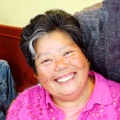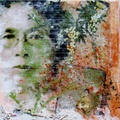To be biracial and Japanese American means having many different labels from which to choose. For this historical overview, we will use “Hapa”, a term popularized by the Hapa Issues Forum, to mean people who have an Asian/Asian Pacific Islander parent and a parent of any other race. Our focus here is on those with a Japanese or a Japanese American parent.
There is no single Hapa experience. Over the decades, Hapas have had widely different experiences based on individual circumstance and background, as well as the time period and environment into which they were born. The history of people of mixed-race has been deeply influenced by the evolving social and legal contexts for interracial relationships and marriages, along with community attitudes about culture, tradition and belongingness. Legal barriers against mixed marriages have fallen; however, discrimination, prejudice, community fears and stereotyping still affect interracial marriages and interracial people today. Nonetheless, about half* of all Japanese American marriages since 1970 have been to non-JAs, and the birthrate of interracial and interethnic children with some Japanese ancestry now exceeds that of JA/JA children. The Japanese American community has been gradually welcoming Hapas as a significant and growing part of the Japanese American community.
Historical Context of Intermarriage
To understand people of mixed race, we must begin with the history of interracial relationships and marriages. The social and legal contexts of such unions have paralleled the history of race-relations in the U.S. Being in a “mixed marriage” or being a “mixed race” person was a vastly different experience 100 years ago than it is today. Anti-miscegenation laws in the United States were in force for over 300 years, leaving the taint of misinformation, prejudice and fears within all communities.
The first anti-miscegenation law, barring marriage between whites and blacks, was passed in Maryland in 1661. By the nineteenth century, such laws had been enacted in most states. In 1880, California passed a law prohibiting the issuing of licenses for marriage between any white person and a “Negro, mulatto, or Mongolian.” (“Mulatto” was a negative word derived from the mixture of a donkey and a horse, producing a mule, which was not itself able to reproduce.) Aimed at the Chinese, the law was supported by the likes of John F. Miller, who said in 1878, “Were the Chinese to amalgamate at all with our people… the result of that amalgamation would be… a mongrel of the most detestable that has ever afflicted the earth.” In 1909, California specifically added the Japanese to the list.
In 1922, the Cable Act decreed that any U.S.-born woman who married a “person ineligible for citizenship” would automatically lose her own U.S. citizenship. The Cable Act was repealed in 1936. However, as recently as 1945, California passed a bill reiterating the ban on marriages between whites and other races. In 1948, the tide began to turn when the California Supreme Court found the State anti-miscegenation laws unconstitutional. However, not until 1967 was the last anti-miscegenation law in the U.S. struck down by the U.S. Supreme Court (Loving vs. Virginia).
Historic Attitudes Towards Mixed-Race People
Prior to World War II, intermarriages were not common. European American attitudes towards Asians, intermarriage and mixed-race children were often fiercely negative. Moreover, many Issei and Nisei held traditional Japanese social attitudes about racial and cultural purity, filial piety, marriage for duty rather than love, and conformity to social norms. These beliefs encouraged many Nikkei to reject those who choose to marry non-Japanese persons, and to ignore, taunt, or abuse Hapa children.
Many older Hapas experienced tremendous discrimination from the JA community, as well as from mainstream society. Stories abound of community insensitivity, rudeness or rejection, often through subtle but hurtful acts of omission, non-acceptance or lack of inclusion, rather than overt acts.
A Nisei woman in her 70s recently spoke of a mixed-heritage Nisei who had been ostracized by the San Francisco community before WWII. The discrimination continued even in the internment camps. She said, “here we were in camp [Tule Lake], all in the same boat, and yet people living in the same block wouldn’t even talk to her, just because she was half Filipino. Years later she thanked me: ‘I’ll always remember that you’re the only who was friendly to me. Everyone else was so mean to me, or ignored me completely.’”
After World War II, several factors, such as the eviction of Japanese Americans from the West Coast, led to an increase in out-marriages in the Japanese American community. Executive Order 90066 initiated the removal of Japanese Americans from concentrated settlements on the West Coast. Some moved inland voluntarily. Others moved to the Midwest and East from the internment camps. Still others were discouraged from returning to the West Coast by government policies of resettlement and forced assimilation. The resulting dispersal of the JA community led to geographic and social isolation from other JAs.
Although relatively few Nisei in largely white communities married non-Japanese, the majority of their children did. For example, in 1984, 75% of Japanese Americans who married in Chicago married whites. Statistical studies indicate that the rate of interracial marriages is significantly higher in areas with a low concentration of Japanese Americans. However, by the 1970s and 190s, many Nikkei had returned to the West Coast. Only about 15% of Japanese Americans currently reside outside of the West Coast and Hawai’i.
Among JAs who returned to the West Coast, some felt great pressure to assimilate with the mainstream, downplay associations with the Japanese community and culture, and increase their identification as “American”. One consequence was in choosing marriage partners without regard to race.
Japanese-born wives of U.S. servicemen
Approximately 150,000 Japanese wives of U.S. servicemen have immigrated to the U.S. since 1945. The majority married whites and ethnic minorities, (perhaps 5% wed Japanese Americans). By conservative estimate, these unions have produced over 300,000 Hapa children.
The term “war bride” is not accurate for the majority of Japanese military wives, because the bulk of these marriages took place after both the U.S. military Occupation of Japan and the Korean War. Prior to 1957, stringent government and military policy discouraged fraternization with the local populace Permission for marriage and U.S. entry were difficult to obtain, requiring background checks and, sometimes, bribes. In some cases, the result was long periods of separation, broken relationships resulting in orphans (“Amerasians”) or difficult immigration experiences.
The number of marriages peaked from 1956-64, after regulations were relaxed. By 1965, intermarriages began to decline as the US had begun reducing troop levels in Japan. Figures continued to drop in the early 1970s as Japan’s rising economy reduced the economic disparity between U.S. military personnel and the Japanese.
Because U.S. military officers were under more pressure to observe non-fraternization regulations, the vast majority of military marriages were with enlisted men. Frequently the wives were idle-class, and better-educated than their husbands, who tended to be Scots-Irish, Jewish, or ethnic minorities, and to come from rural or working class families. In terms of class and education, the wives had higher perceived status than their husbands. Perhaps because of this, and the fact they tended to socialize primarily with other Japanese military wives, these mothers often had tremendous influence on the cultural values of their children, some of whom experienced themselves as more Japanese than “American”.
Economic and social opportunities and changing social mores.
The late 1940s through 1960s saw steady gains in civil rights for minorities. In addition to the overturning of anti-miscegenation laws, race restrictive housing covenants were ruled unconstitutional, and opportunities steadily increased in education and employment. Increased socio-economic success, status and education resulted in more contact with European Americans and other races.
The civil rights movement also increased multicultural consciousness and cross-racial political and community involvement. In the decades following the 1950s, gender and sex-role scripts loosened throughout American society. Cultural expectation about relationships, mates, marriages and parenting became more fluid.
These postwar circumstances led not only to increased intermarriages, but also changes in the entire Nikkei culture, with identity, historical preservation, interethnic relationship and community issues that we are still trying to fully assess.
As the churches, social clubs, and neighborhoods that once defined community have become less sustainable than in the past, an individual’s sense of community identity has become more and more a matter of individual choice and selection. Previously, Japanese Americans had had two choices: the organic JA community or Anglo-assimilation. However, in the past 20 years, with the globalization of the economy and shifting migration and immigration patterns, as well as the rise of civil rights and integration, two additional identity choices have arisen: multi-racial and Pan-Asian.
That Japanese Americans are taking advantage of these choices can be seen by the following demographic trends. Although U.S. census data indicate that the percentage of JAs nationwide who marry non-Japanese has remained roughly 50% since 1970 to 25% in 1990. At the same time, marriages to other Asians has risen from 2-3% to 21-22.5% of all marriages, so almost as many marriages now take place between JAs and other Asians as between JAs and whites. (Contrary to popular belief, among U.S.-born JAs, men out-marry almost as often as women.)
A similar trend is occurring among Hapas. Prior to the early 1990s, Hapas had only one choice — Anglo-assimilation — 99% married whites. However, with increasing acceptance within the Japanese American community, the rise of multi-cultural and Pan-Asian identities, and more sense of space for the individual to choose the identity that fits best, the marriage rate of Hapas to whites has dropped to 75%. 25% are now marrying Asians or Latinos.
Note:
*Statistical information for this article, based on studies of census and marriage license data, has been provided by Larry Shinagawa, Ph.D., professor of American multicultural studies at Sonoma State University.
*This article was originally published in Nikkei Heritage Vol. X, Number 4, (Fall 1998), a journal of the National Japanese American Historical Society.
© 1998 National Japanese American National Museum









